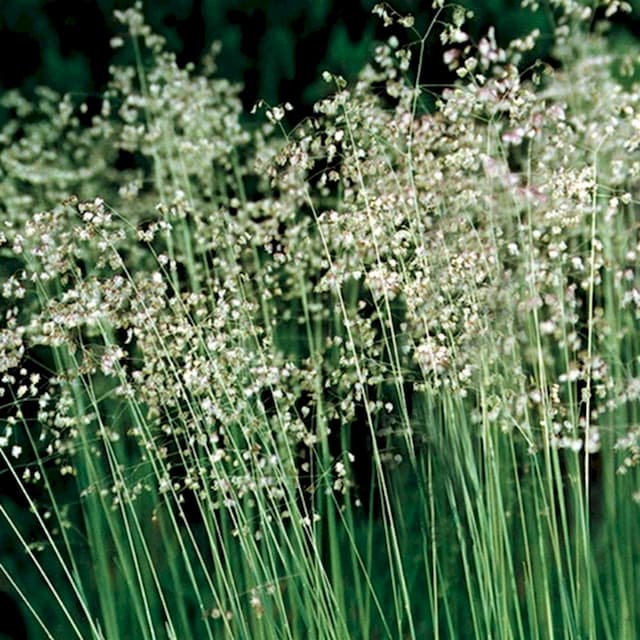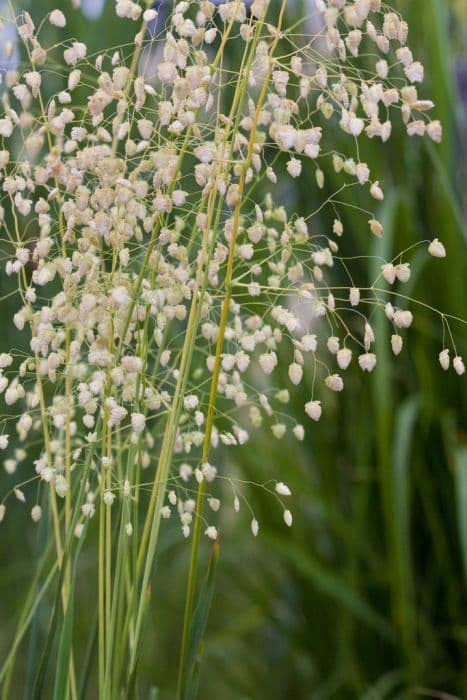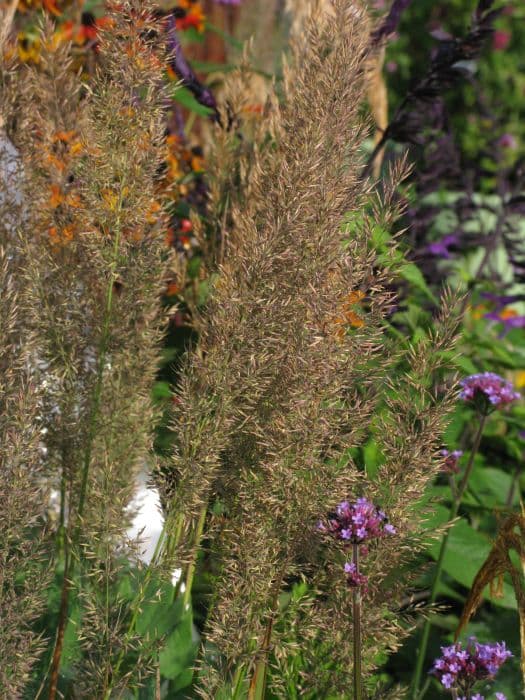Reed Mannagrass Glyceria maxima

ABOUT
The plant known as Reed Sweet-grass has a robust and lush appearance. Its leaves are long, bright to dark green, and taper to a point at the end. These leaves are flat and often harsh to the touch due to their serrated edges, which can give them a slightly rough texture. The plant forms thick clumps and its stem is sturdy, supporting the weight of the leaves and the flower head. The flower head of the Reed Sweet-grass is typically a loosely branched panicle, radiating outwards, with a silky and feathery look. During its flowering season, it produces a bounty of these flower heads, which are often light green to purplish in color, becoming more tan as they mature. The individual flowers on the panicles are small and may not be immediately noticeable until they are viewed up close. The plant overall has a dense, grassy habit that makes it quite noticeable in its native wetland habitats. It often grows in dense stands near the edges of water bodies, contributing to the lush greenery of these areas. The Reed Sweet-grass' preference for wet soils is reflected in its vigorous growth in these conditions, where it can be a dominant presence among other aquatic and semi-aquatic plants.
About this plant
 Names
NamesFamily
Poaceae
Synonyms
Reed Mannagrass, Reed Sweet-grass, Greater Sweet-grass, Tall Mannagrass
Common names
Festuca aquatica, Glyceria aquatica, Molinia maxima, Panicum maximum, Poa aquatica, Poa maxima.
 Toxicity
ToxicityTo humans
Reed sweet-grass is not commonly recognized as a toxic plant to humans. However, as with many other plants, individual sensitivities can vary, and it's generally prudent to avoid ingesting plants that are not commonly recognized as food plants due to the potential of allergic reactions or unknown compounds that could be harmful when consumed in large quantities.
To pets
Reed sweet-grass is also not widely known to be toxic to pets. Nevertheless, it is important for pet owners to prevent their animals from eating ornamental plants, as the ingestion of non-food plants can sometimes cause gastrointestinal upset or other issues in pets, even if the plant is not specifically toxic. If a pet exhibits signs of distress after ingesting any plant material, a veterinarian should be consulted.
 Characteristics
CharacteristicsLife cycle
Perennials
Foliage type
Deciduous
Color of leaves
Green
Flower color
Green
Height
3 feet (0.91 meters)
Spread
3 feet (0.91 meters)
Plant type
Herb
Hardiness zones
4
Native area
Europe
Benefits
 General Benefits
General Benefits- Water purification - Glyceria maxima plays a role in nutrient removal in water bodies, helping to improve water quality by absorbing excess nitrogen and phosphorus.
- Wildlife habitat - It provides shelter and breeding grounds for various aquatic species including insects, birds, and amphibians.
- Erosion control - The robust root system of the reed mannagrass stabilizes soil and prevents erosion along waterways.
- Ornamental use - With its tall and graceful foliage, reed mannagrass is sometimes used in water gardens and natural landscaping for aesthetic purposes.
- Forage for livestock - It can be used as a forage plant for livestock, particularly in wetter areas where other forage plants may not thrive.
 Medical Properties
Medical Properties- This plant is not used for medical purposes.
 Air-purifying Qualities
Air-purifying QualitiesThis plant is not specifically known for air purifying qualities.
 Other Uses
Other Uses- Glyceria maxima, commonly known as reed sweet-grass, can be woven into baskets or mats due to its long and durable leaves.
- The grass can be used in the construction of thatched roofs, offering a traditional and sustainable roofing material.
- It serves as excellent forage for livestock, particularly waterfowl, when other food sources are scarce.
- The plant can be involved in phytoextraction to remove heavy metals from contaminated soils, helping to remediate polluted areas.
- Reed sweet-grass can be processed into paper or cardboard, utilizing its high cellulose content as a raw material.
- Dried stems of the plant are sometimes used in floral arrangements and ornamental crafts due to their aesthetic appeal.
- As part of a bioplastics formulation, components derived from Glyceria maxima may be used as a sustainable alternative to conventional plastics.
- The dense growth habit can provide erosion control in waterways and on riverbanks, reducing soil loss and protecting habitats.
- It is employed in wastewater treatment systems as a biological filter to reduce nutrient loads, especially in constructed wetlands.
- Glyceria maxima can be used as a natural dye source, with various parts of the plant providing green hues for textiles.
Interesting Facts
 Feng Shui
Feng ShuiThe Reed Sweet-grass is not used in Feng Shui practice.
 Zodiac Sign Compitability
Zodiac Sign CompitabilityThe Reed Sweet-grass is not used in astrology practice.
 Plant Symbolism
Plant Symbolism- Adaptability: Glyceria maxima, commonly known as Reed Mannagrass, often thrives in waterways and wetlands, symbolizing the ability to adapt and flourish in various environments.
- Growth: As a fast-growing plant, Reed Mannagrass represents rapid growth and expansion, both physically and metaphorically in one's life.
- Resilience: Its capacity to withstand waterlogged conditions and still prosper makes it a symbol of resilience and strength in adversity.
- Flexibility: The plant's flexible stems that bend with the water current signify flexibility and the importance of going with the flow in life's situations.
 Water
WaterThe most common common name for Glyceria maxima is Reed Sweet-grass. To properly water Reed Sweet-grass, which is a wetland plant, maintain consistently moist soil or shallow water conditions. It thrives when the roots are submerged, so it is best to water it thoroughly until the surrounding soil or the container is saturated. Aim for at least one to two gallons per week, depending on the size of the plant and the environmental conditions. During hotter and drier periods, increase the water frequency to ensure the soil does not dry out, as Reed Sweet-grass prefers wet habitats.
 Light
LightReed Sweet-grass thrives best in full sunlight to partial shade. The optimal spot for this plant is an area where it will receive at least six hours of direct sunlight daily, which promotes vigorous growth and health. However, it will tolerate some shade, especially in the afternoon when the sun is at its most intense.
 Temperature
TemperatureReed Sweet-grass can generally tolerate a wide range of temperatures but prefers temperate climates. It can survive in temperatures as low as 20°F and as high as 90°F. The ideal temperature for Reed Sweet-grass is between 60°F and 75°F, where it is likely to grow most vigorously.
 Pruning
PruningPruning Reed Sweet-grass is beneficial for removing old or damaged foliage and encouraging fresh growth. Prune it in late winter or early spring before new growth begins. Cutting back the foliage to a few inches above the ground annually helps maintain the health and appearance of the plant. Prune as needed to control the plant's spread, as Reed Sweet-grass can become invasive if left unchecked.
 Cleaning
CleaningNot needed
 Soil
SoilReed sweetgrass, also known as Glyceria maxima, thrives best in a soil mix that is consistently moist, nutrient-rich, and loamy. Amend regular potting soil with compost and peat to increase water retention and fertility. Optimal pH levels for reed sweetgrass range from neutral to slightly acidic, 6.5 to 7.2.
 Repotting
RepottingReed sweetgrass does not require frequent repotting. It is a vigorous plant that can be divided and repotted every 2-3 years, or when it outgrows its current pot.
 Humidity & Misting
Humidity & MistingReed sweetgrass prefers high humidity levels, often thriving at or above 60% humidity, which is common in its natural wetland habitats.
 Suitable locations
Suitable locationsIndoor
Not ideal for indoor growing; reed sweetgrass needs space and moisture.
Outdoor
Plant in moist soil beside water, full sun to partial shade.
Hardiness zone
4-9 USDA.
 Life cycle
Life cycleGlyceria maxima, commonly known as Reed Mannagrass, begins its life cycle as a seed typically germinating in the spring once temperatures rise and conditions become favorable. Upon germination, the seed establishes a root system and a shoot that grows upward, forming a small seedling and translating to the vegetative growth stage where leaves develop and photosynthesis begins. The plant then enters a phase of rapid growth, producing tall, robust stems and long, linear leaves that are a characteristic of mature Reed Mannagrass. The reproductive stage follows when the plant develops inflorescences, typically in the early summer, consisting of spikelets that contain the reproductive organs. After pollination, which is mostly wind-assisted, the plant produces seeds that eventually mature and disperse in late summer or early autumn, completing the reproductive cycle. The plant may then experience senescence in late autumn or persist as an evergreen, depending on the climate, before the cycle starts anew with the next season's growth.
 Propogation
PropogationPropogation time
Spring to summer
For tall mannagrass, the most popular method of propagation is by division. This is typically done in the spring when the plant is actively growing. To propagate by division, gardeners should carefully dig up the entire plant, ensuring to maintain a good amount of roots attached. Once the plant is uprooted, they can use a sharp spade or knife to cut the plant into smaller sections, making sure each section has at least one growing point or shoot and a portion of the root system. These sections are then replanted at the same depth they were growing at originally, spaced about 18 to 24 inches (45 to 60 cm) apart to allow for growth. After planting, the divisions should be watered thoroughly to help establish them in their new locations.









